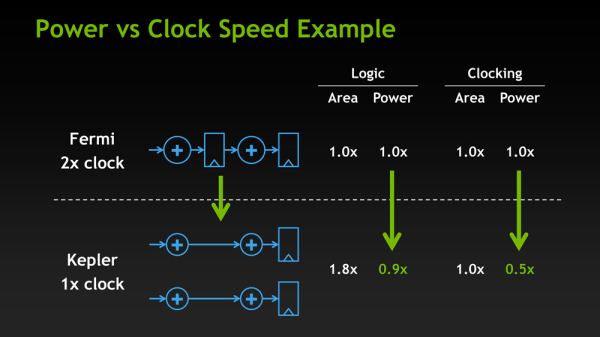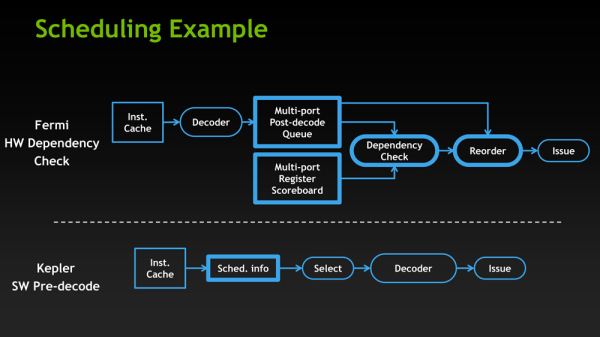NVIDIA GeForce GTX 680 Review: Retaking The Performance Crown
by Ryan Smith on March 22, 2012 9:00 AM ESTThe Kepler Architecture: Efficiency & Scheduling
So far we’ve covered how NVIDIA has improved upon Fermi for; now let’s talk about why.
Mentioned quickly in our introduction, NVIDIA’s big push with Kepler is efficiency. Of course Kepler needs to be faster (it always needs to be faster), but at the same time the market is making a gradual shift towards higher efficiency products. On the desktop side of matters GPUs have more or less reached their limits as far as total power consumption goes, while in the mobile space products such as Ultrabooks demand GPUs that can match the low power consumption and heat dissipation levels these devices were built around. And while strictly speaking NVIDIA’s GPUs haven’t been inefficient, AMD has held an edge on performance per mm2 for quite some time, so there’s clear room for improvement.
In keeping with that ideal, for Kepler NVIDIA has chosen to focus on ways they can improve Fermi’s efficiency. As NVIDIA's VP of GPU Engineering, Jonah Alben puts it, “[we’ve] already built it, now let's build it better.”
There are numerous small changes in Kepler that reflect that goal, but of course the biggest change there was the removal of the shader clock in favor of wider functional units in order to execute a whole warp over a single clock cycle. The rationale for which is actually rather straightforward: a shader clock made sense when clockspeeds were low and die space was at a premium, but now with increasingly small fabrication processes this has flipped. As we have become familiar with in the CPU space over the last decade, higher clockspeeds become increasingly expensive until you reach a point where they’re too expensive – a point where just distributing that clock takes a fair bit of power on its own, not to mention the difficulty and expense of building functional units that will operate at those speeds.
With Kepler the cost of having a shader clock has finally become too much, leading NVIDIA to make the shift to a single clock. By NVIDIA’s own numbers, Kepler’s design shift saves power even if NVIDIA has to operate functional units that are twice as large. 2 Kepler CUDA cores consume 90% of the power of a single Fermi CUDA core, while the reduction in power consumption for the clock itself is far more dramatic, with clock power consumption having been reduced by 50%.
Of course as NVIDIA’s own slide clearly points out, this is a true tradeoff. NVIDIA gains on power efficiency, but they lose on area efficiency as 2 Kepler CUDA cores take up more space than a single Fermi CUDA core even though the individual Kepler CUDA cores are smaller. So how did NVIDIA pay for their new die size penalty?
Obviously 28nm plays a significant part of that, but even then the reduction in feature size from moving to TSMC’s 28nm process is less than 50%; this isn’t enough to pack 1536 CUDA cores into less space than what previously held 384. As it turns out not only did NVIDIA need to work on power efficiency to make Kepler work, but they needed to work on area efficiency. There are a few small design choices that save space, such as using 8 SMXes instead of 16 smaller SMXes, but along with dropping the shader clock NVIDIA made one other change to improve both power and area efficiency: scheduling.
GF114, owing to its heritage as a compute GPU, had a rather complex scheduler. Fermi GPUs not only did basic scheduling in hardware such as register scoreboarding (keeping track of warps waiting on memory accesses and other long latency operations) and choosing the next warp from the pool to execute, but Fermi was also responsible for scheduling instructions within the warps themselves. While hardware scheduling of this nature is not difficult, it is relatively expensive on both a power and area efficiency basis as it requires implementing a complex hardware block to do dependency checking and prevent other types of data hazards. And since GK104 was to have 32 of these complex hardware schedulers, the scheduling system was reevaluated based on area and power efficiency, and eventually stripped down.
The end result is an interesting one, if only because by conventional standards it’s going in reverse. With GK104 NVIDIA is going back to static scheduling. Traditionally, processors have started with static scheduling and then moved to hardware scheduling as both software and hardware complexity has increased. Hardware instruction scheduling allows the processor to schedule instructions in the most efficient manner in real time as conditions permit, as opposed to strictly following the order of the code itself regardless of the code’s efficiency. This in turn improves the performance of the processor.
However based on their own internal research and simulations, in their search for efficiency NVIDIA found that hardware scheduling was consuming a fair bit of power and area for few benefits. In particular, since Kepler’s math pipeline has a fixed latency, hardware scheduling of the instruction inside of a warp was redundant since the compiler already knew the latency of each math instruction it issued. So NVIDIA has replaced Fermi’s complex scheduler with a far simpler scheduler that still uses scoreboarding and other methods for inter-warp scheduling, but moves the scheduling of instructions in a warp into NVIDIA’s compiler. In essence it’s a return to static scheduling.
Ultimately it remains to be seen just what the impact of this move will be. Hardware scheduling makes all the sense in the world for complex compute applications, which is a big reason why Fermi had hardware scheduling in the first place, and for that matter why AMD moved to hardware scheduling with GCN. At the same time however when it comes to graphics workloads even complex shader programs are simple relative to complex compute applications, so it’s not at all clear that this will have a significant impact on graphics performance, and indeed if it did have a significant impact on graphics performance we can’t imagine NVIDIA would go this way.
What is clear at this time though is that NVIDIA is pitching GTX 680 specifically for consumer graphics while downplaying compute, which says a lot right there. Given their call for efficiency and how some of Fermi’s compute capabilities were already stripped for GF114, this does read like an attempt to further strip compute capabilities from their consumer GPUs in order to boost efficiency. Amusingly, whereas AMD seems to have moved closer to Fermi with GCN by adding compute performance, NVIDIA seems to have moved closer to Cayman with Kepler by taking it away.
With that said, in discussing Kepler with NVIDIA’s Jonah Alben, one thing that was made clear is that NVIDIA does consider this the better way to go. They’re pleased with the performance and efficiency they’re getting out of software scheduling, going so far to say that had they known what they know now about software versus hardware scheduling, they would have done Fermi differently. But whether this only applies to consumer GPUs or if it will apply to Big Kepler too remains to be seen.












404 Comments
View All Comments
CeriseCogburn - Tuesday, March 27, 2012 - link
What you're saying is true for amd cards, and is severe in CF, but true across the board.Lower clocked cpu system, better results from Nvidia.
bozolino - Monday, March 26, 2012 - link
I dont know whats happening. I have a gtx 560 2win and wanted to compare it to the 680 and see if its worth the replace but the charts cant be compared, for example:http://www.anandtech.com/show/5048/evgas-geforce-g...
This review uses an i7 3xxx while the older uses an i7 720, how can the older cpu performs better than the new one?? Something is very odd....
I wish they had used same computer as vga test bench, so we could compare all the results together....
Sharpie - Monday, March 26, 2012 - link
Its about design trade offs, you can increase the memory speed if you have a narrow bus to get the same throughput of something with lower clock speed and a large bus. all depeends on the architectural design so arguing about clock numbers is pointless generally speaking unless you are comparing apples to apples. Comapring an NVidia chip to an ATI chip is apples to oranges. Yes, im an engineer.CeriseCogburn - Tuesday, March 27, 2012 - link
Oh I get it you're in some pretend world where the card companies are not "fanboy compared" in the article itself.Once the amd card loses, and someone tells the truth about that, it's trolling or fanboy right ?
If an amd fan lies, it's "a good opinion".
If an amd fan liar gets corrected, that's "taking it too far" into "fanboy".
Once aghain, telling the truth on the two competing cards is forbidden only if it's an Nvidia advantage - then WE MUST OMIT the AMD card from the analysis, right ?
I think you might as well NEVER read another article on a card launch at this site, if you intend to stick to your RUDE comment.
CeriseCogburn - Tuesday, March 27, 2012 - link
Heck you didn't read this article nor many others then that say and prove the exact thing.I'm sure it will never make sense to you.
SlyNine - Friday, April 27, 2012 - link
Actually, I'm pretty sure it's you that doesn't understand the DX API. The CPU's are doing roughly the same thing for both videocards. Cept when it comes to processing the Drivers.CeriseCogburn - Tuesday, March 27, 2012 - link
The GTX690 currently holds the world record with a 1,900mhz overclock, and is gaining easily 15% with noob out of box overlclocks, and reaching very high memory clocks as well as 1,300+ core, I've seen 1,420 on air, and overclocked models are on their way....So much for that fud about 7970... it's FUD FUD and pure FUD.
blanarahul - Tuesday, March 27, 2012 - link
GTX 690????blanarahul - Tuesday, March 27, 2012 - link
Smart move by NVIDIA. Make a single gpu powerful graphics card to battle the Dual Tahiti monster. Judging by how they are doing the GTX 680 it should have the following specs:-4.72 billion transiostors
2048 CUDA Cores
384-bit memory bus width
3 GB VRAM
600-700 USD
TDP of 225-250W
If the clock speeds high enough, it will be quite a match for the 7990!
The reason i think it will be a single GPU card is because GTX 680=2x GTX 560 Ti.
So it should be GTX 690=2x GTX 580.
CeriseCogburn - Tuesday, March 27, 2012 - link
The release date of the 7970 was jan 11th, 2.5 months is opverstating in AMD's favor...Nothing like not knowing what you're talking about huh.
7970's have come down in price a bit, but you still will find them for much more than $569 at an awful lot of USA online places.